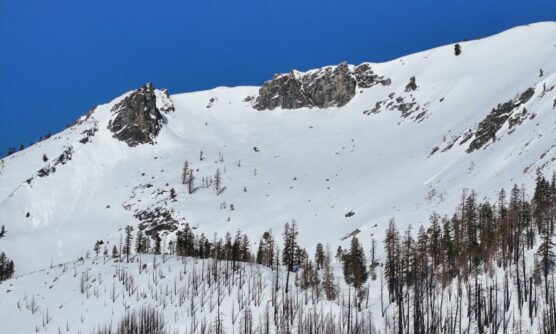California’s first winter snowpack survey of 2025 showed the snowpack at 91% of the average to date and 37% of the average on April 1, when the Sierra snowpack is typically at its peak.
The state Department of Water Resources conducts the official survey at Phillips Station, nestled in the crest of the Sierra near South Lake Tahoe. The snowpack acts as a reservoir for the state: As spring approaches and the snowpack melts, the water runs off into local streams and rivers, then state-run canals and dams for storage and use. Experts say that nearly a third of the water used in California annually comes from the snowpack.
Andy Reising, manager of the Department of Water Resources’ snow surveys and water supply forecasting unit, said the snow depth was 24 inches. That’s a good start, according to officials, but more storms are needed especially in Central and Southern California, which are typically drier than Northern California.
“As of right now, I am feeling OK, but we’ll need a progression of monthly storms to keep going,” Reising said.
The health of the snowpack is paramount to California’s agriculture industry, the largest in the nation. Last week, state officials told farmers that they would get more water in 2025 than previously expected because of a series of storms at the end of 2024. California farms can now expect to get 15% of their requested supplies instead of 5%, a number that could rise again if more rain and snow fall.
“While our snowpack looks good now, we have a long way until April when our water supply picture will be more complete,” said Department of Water Resources director Karla Nemeth. “Extreme shifts between dry and wet conditions are continuing this winter and if the past several years are any indication, anything could happen between now and April and we need to be prepared.”
During the first snowpack survey of 2024, California began the season with below-normal mountain snowpack and a water content of about 25% of the average. By April, the water content measured 110% of the average.
Electronic readings from 130 stations placed throughout the Sierra Nevada indicate the statewide snowpack’s snow water equivalent is 10.7 inches, or 108% of average for this date, compared to 28% on this date last year.
“We are fortunate to have had several solid snow-producing atmospheric river systems so far this season. The fall was extremely dry, so our healthy snow totals are thanks to a handful of big storm systems in November and late December,” Reising said. “But to finish the year where we need to be, we will still need additional snow building at a regular pace throughout the winter.”
Major reservoirs in California are currently 121% of average thanks to two consecutive years of above-average snowpack, which occurred after the driest three-year period on record in California history.
To prepare for these swings between extreme conditions, DWR is investing in floodplain and flood infrastructure improvements and groundwater recharge efforts, hoping to capture and use as much water as possible during flood conditions.
The Department of Water Resources conducts four media-oriented snow surveys at Phillips Station each winter near the first of each month, January through April, and, if necessary, May. The next survey is tentatively scheduled for Feb. 3.
Like this:
Like Loading...
Related





 Tweet This
Tweet This Facebook
Facebook Digg This
Digg This Bookmark
Bookmark Stumble
Stumble RSS
RSS


























REAL NAMES ONLY: All posters must use their real individual or business name. This applies equally to Twitter account holders who use a nickname.
0 Comments
You can be the first one to leave a comment.